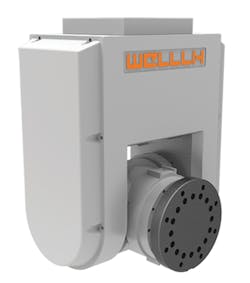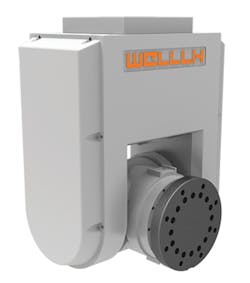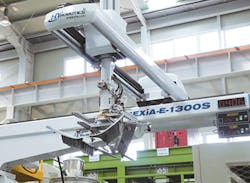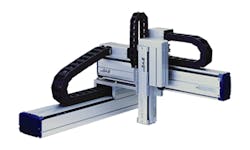Special Report: 3-axis robots faster, smarter, more flexible
Advances in three-axis Cartesian robots are bringing new capabilities to plastics processing plants. Molders can expect these linear robots to deliver higher speeds and bigger payloads.
Daryl Isken, national sales manager of Star Automation Inc., Menomonee Falls, Wis., said the need for greater precision has resulted in increased demand for three-axis gantry robots for assembly operations. Meanwhile, molding requirements have also increased, with more applications using multicavity molds (up to 100 cavities or more) or calling for high speeds. "We are seeing a lot of applications with cycle times of 6 seconds or less," he said.
To meet these requirements, the company is supplying units with vertical carbon-fiber arms that are equipped with larger servo drives, enabling them to handle higher cavitation, faster cycle times and bigger payloads.
SERVO MOTORS GAIN MOMENTUM
One of the major trends driving the performance of three-axis robots is the use of servo motors, which have decreased in cost. Servos have long been used to drive the main X, Y and Z axes. The newest innovations are servo-driven wrist motions at the rotational axes at the end of the main axes, essentially adding a fourth, fifth or sixth axis to traditional three-axis linear robots. The result is much greater precision and smoother operation of the main axes and the wrist motions that drive the end-of-arm tooling. Meanwhile, sensing device improvements have led to higher quality parts.
Bob Shingledecker, VP and GM of Absolute Robot Inc., Worcester, Mass., which distributes Well-Lih robots in the U.S., said servos are rapidly replacing pneumatically driven wrist action. "Years ago, that wasn't available, and as it became available, it wasn't affordable for most people," he said. "Now it is available and is very affordable."
Shingledecker said compared to the movements produced by pneumatics, servo motions provide much more accuracy and flexibility. Using pneumatics, wrist motions would move through arcs of 0 to 90 degrees or 0 to 180 degrees and come to hard stops. With servo-driven wrist motions, "I can now make that servo go from 0 to 360 degrees in any increment down to a tenth of a millimeter," he said.
SMARTER SENSING DRIVES QUALITY
Robots have become increasingly sophisticated in sensing payloads and adjusting take-out speed. A recent development from Engel Austria GmbH, Schwertberg, is iQ vibration control, a feedback technology that uses a sensor on the robot axis to actively eliminate vibrations from internal or external sources. Walter Aumayr, director of automation worldwide for Engel, described a feature that allows the robot to sense the payload and automatically adjust the take-out speed.
Years ago, the company supplied drives in different versions depending on the payload. "Now, our robots recognize the load itself and adjust the dynamic data for the robot," he said, adding that the vibration control technology optimizes the movement and improves the robot's positioning and repeatability. The technology was introduced last year at Fakuma and it is now a standard feature.
HYRobotics Corp., St. Louis, has introduced Muge:in, a weight-detection take-out robot that measures the weight of the molded part. The system features a load cell on the robot arm that weighs the part as it is being picked out of the mold. According to Sam Lee, GM of HYRobotics, the device is designed to work with injection molding machines with clamping forces of 300 to 3,000 tons. It can measure molded parts from 100 grams to 20 kilograms, to a tolerance of plus or minus 3 grams. Defective parts can be segregated from good parts. Weight data can be collected and downloaded for review, and also can be viewed on a smartphone.
An Alabama-based automotive parts manufacturer is using the HYRobotics weight-detection system to make parts for Korean automakers Kia and Hyundai.
MORE LINEAR ROBOTS MAKE THEIR DEBUT
Ranger Automation Systems Inc., Shrewsbury, Mass., has introduced the SA series of floor-mounted and side-entry robots, for applications that include horizontal presses in low overhead areas. According to John Campbell, the company's national sales manager, features include servo-driven wrist motions, which allow for increased precision, reduced mold open time and faster rotation of end-of-arm tooling without vibration. Single, double or triple servo-wrist options are available, which upgrades the three-axis robot to four, five or six axes, enabling it to combine articulated motion with the benefits of the fast takeout and travel of a linear-beam robot.
While many of the technical advances benefit injection molders, manufacturers who perform other processes are seeing improvements as well. Case in point: thermoforming, where high-speed robots are reducing labor needs and upgrading the handling of parts coming off the line. Ranger Automation has recently introduced an SW series three-axis gantry robot aimed at thermoforming lines for thin-walled products. The robot straddles the thermoforming line for pick-and-place tasks. It operates at high speeds, cycling as fast as 3 seconds, according to Campbell. He said the company started shipping the line in 2015.
TM Robotics (Americas) Inc., Elk Grove Village, Ill., a unit of Toshiba Machine Industrial Robots, has launched its BA-III series of Cartesian robots. According to TM Robotics Executive VP Ryan Guthrie, the series, which features an improved mechanical structure, represents a redesign of its Cartesian robots. Upgrades include stronger linear rails and sealed bearings that reduce maintenance requirements. The maximum stroke has been increased from 8.2 feet to 14.8 feet.
Guthrie said the company's three-axis robots are designed for machine-side automation and assembly tasks, rather than simple take-out tasks. All of the robots' motions are servo driven.
Wittmann Battenfeld Inc., Torrington, Conn., in June introduced three new robots for injection molding machines. The W853 pro and W863 pro are designed for machines of 1,433 to 2,646 tons. Gear racks drive the X and Z axes of both robots, while a high-precision recirculating linear ball-bearing system provides carriage guidance. A gear rack and belt provide vertical strokes ranging from 6.6 feet to 9.8 feet. The W853 pro has a payload capacity of about 88 pounds and the W863 pro is rated for a payload of about 165 pounds. Both robots have the EcoVacuum function, which reduces costs and energy usage by minimizing the robot's demand for compressed air.
On the other side of the size spectrum, Wittmann offers the new WL80, its smallest robot for the compact market. Designed with a payload capacity of 4.4 pounds, the WL80 integrates the energy chain into the horizontal arm, which minimizes its space requirement. It is available with a horizontal stroke of nearly 4 feet and is suited for injection molding machines with clamping forces from 33 to 66 tons. The vertical stroke is 2.3 feet and the unit can be equipped with a second vertical axis.
Wittmann national sales manager Tom Schaffner said the company uses the same controller on all of its robots, from the smallest units to the largest. "You have the same programming, the same flexibility on all of your robots," he said. "You don't have a lower end that limits the I/O or programming capability, or a high-end controller where you can do everything. Our controller can handle the easiest to the most complex tasks."
He added that this has enabled technicians to perform programming tasks, rather than be forced to rely on an engineer. This flexibility allows more molding shops to design and build their own automation work cells, rather than purchase turnkey automation systems from robot suppliers or third-party integrators.
John DeGaspari, senior correspondent
Contact:
Absolute Robot Inc., 508-792-4305, www.absoluterobot.com
Engel Machinery Inc., 717-764-6818, www.engelglobal.com/us
HYRobotics Corp., 314-574-5777, www.hyrobotics.com
Ranger Automation Systems Inc., 508-842-6500, www.rangerautomation.com
Star Automation Inc., 262-253-3550, www.starautomation.com
TM Robotics (Americas) Inc., 847-709-7308, www.tmrobotics.com
Wittmann Battenfeld Inc., 860-496-9603, www.wittmann-group.com



